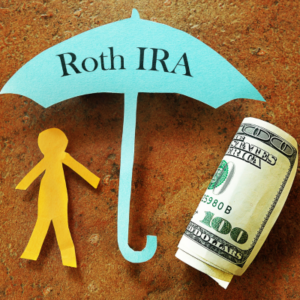An Alternative Solution To A Roth Conversion
The Motley Fool Embraces the Use of Variable Life Insurance as an Alternative to a 401K – well, not really.
In a recent article in The Motley Fool dated July 2, 2023, entitled The No-Brainer Retirement Account that I’d Choose Way Before a 401K, Justin Pope INADVERTANTLY makes a strong case for why a well-structured Variable Universal Life policy is an attractive alternative to a 401K Plan. His “Key Points” are listed below:
 What Justin Pope is really talking about is a Roth IRA, which as we all know is NOT available to all taxpayers and has limited contribution amounts. He discussed this in his article.
What Justin Pope is really talking about is a Roth IRA, which as we all know is NOT available to all taxpayers and has limited contribution amounts. He discussed this in his article.
What about high-income earners over the Roth limits? Mr. Pope DOES offer a possible solution:
“Don’t worry if you’re a high earner; you’re not entirely left in the cold. There are some workarounds for a Roth IRA’s income limits, including the backdoor Roth strategy. In other words, high earners can convert tax-deferred accounts into a Roth IRA if they’re willing to deal with a potential tax hit as converted funds are usually considered taxable income for that year.”
I bolded the “if” statement because it is a BIG IF and should not be discounted so quickly given the availability of other alternatives. The income taxes due on a Roth conversion could be substantial!
 The author states three reasons to invest in a Roth versus a traditional 401K:
The author states three reasons to invest in a Roth versus a traditional 401K:
1. Pay your taxes now, not later – which makes the argument that “you’re withdrawing not only your contributions later on but also all of your investment earnings tax-free. That’s tremendous tax savings if your investments grow a lot over the years”.
2. Superior investment flexibility – which makes the case that many employer-sponsored 401K plans have limited investment options. Not sure that I agree with that, but, he said it.
3. Growth and dividend investors, rejoice! – which highlights the fact that capital gains for growth investments and dividends for equity income investments escape taxation on an annual basis if owned by a Roth IRA.
I am a big fan of Roth IRAs, by the way. I helped my 20-year-old open one when he was in college and told him to diligently continue to make contributions every month, explaining to him the benefits of dollar cost averaging and the time value of compounding. He is now 31 years old and continues to make contributions to his Roth IRA to this day.
 With that said, there is another investment vehicle that has the same, possibly better, benefits than a Roth IRA but people either don’t know about it or don’t understand it. It is called VARIABLE LIFE INSURANCE and, if structured properly, has all the benefits of a Roth WITHOUT the MAGI limits for high-income earners and ZERO contribution limits. Furthermore, it has all the benefits that Mr. Pope highlights in his article.
With that said, there is another investment vehicle that has the same, possibly better, benefits than a Roth IRA but people either don’t know about it or don’t understand it. It is called VARIABLE LIFE INSURANCE and, if structured properly, has all the benefits of a Roth WITHOUT the MAGI limits for high-income earners and ZERO contribution limits. Furthermore, it has all the benefits that Mr. Pope highlights in his article.
Let’s unpack those benefits.
As the article states:
1. Contribution (premium) amounts are paid after income taxes, so as Mr. Pope suggests, you are paying your taxes now, but all your investment earnings are distributed tax-free. In fact, cash value life insurance such as Variable Life, allows you to withdraw your cost basis tax-free first, before any earnings or investment gains are distributed. Generally, gains are distributed after all basis withdrawals via zero-cost loans to the policy owner.
2. Contrary to Mr. Pope’s statement about limited offerings in 401K plans, Variable Life offerings from most insurance companies offer 75+ sub-accounts from such funds families as Fidelity, Vanguard, Dimensional Fund Advisors (DFA), BlackRock, T. Rowe Price, American Funds, Rydex, PIMCO and many more, with a wide variety of investment objectives, all under one roof.
3. Like a Roth IRA, dividends and capital gains earned in the sub-accounts in a Variable Life policy (often paid annually or more frequently), as well as any gains on fund exchanges, are completely tax-free.
Additionally,
4. Unlike a Roth IRA, upon transfer to non-spousal beneficiaries, the funds in Variable Life do not need to be distributed within 10 years and are NOT subjected to income tax on any earning gains – the entire amount is ALWAYS income tax-free. Failure to meet the 10-year timeline for draining a Roth IRA can create substantial IRS penalties, like 50%!!!
5. Unlike a Roth IRA, there are no taxes due on Variable Life benefits upon generational transfer to non-spousal beneficiaries – EVER! The proceeds (basis and gains) are ALWAYS income tax-free, so long as the contract qualifies as life insurance under the IRS guidelines in Section 7702.
6. Unlike a Roth IRA, Variable Life can also be structured to escape any state or federal transfer taxes if owned by someone other than the insured, such as a trust. This becomes more meaningful for high-net-worth clients.
7. Unlike a Roth IRA, there are NO contribution or income limitations. THIS IS AN IDEAL SOLUTION FOR HIGH-INCOME EARNERS. Put in as much as you want, so long as you can financially justify the amount of insurance and design the contract to meet the Non-Modified Endowment Contract rules (Non-MEC).
 8. Variable Life insurance includes a benefit at death which can multiply the value of the underlying account upon premature death, depending on how the insurance is designed. Alternatively, the sub-account investments can be paid out to the beneficiaries, plus a pre-determined amount of insurance, also completely tax-free.
8. Variable Life insurance includes a benefit at death which can multiply the value of the underlying account upon premature death, depending on how the insurance is designed. Alternatively, the sub-account investments can be paid out to the beneficiaries, plus a pre-determined amount of insurance, also completely tax-free.
9. Through plan design and administration, the cost of insurance can be substantially minimized as compared to traditional life insurance. The aforementioned IRS Section 7702 was updated in January 2022, making life insurance an even more cost-efficient solution. See the article by Justin Charise, CFP® in Worth Magazine from March 2022 entitled Why Are The Recent Changes To IRS Code 7702 A Big Deal For High-Income Earners?
10. Additional benefits can be added to a Variable Life policy for an additional cost, such as Long-Term Care, Chronic Illness, and Terminal Illness riders.
Then there is this …
Kate Dore, CFP®, from CNBC, wrote an article on July 5, 2023, titled Millions of high earners pay this investment income tax every year. Here’s how to avoid it. In the article, she discusses the fact that the 3.8% tax on net investment income (capital gains, dividends, interest, and more) levied on individuals with Modified Adjusted Gross Income (MAGI) of $200,000 or more ($250,000 for joint filers) has not been adjusted for inflation since it was enacted with the Affordable Care Act of 2013. As wages have increased over the past decade, more and more taxes are being paid by high-wage earners. More of a reason to make contributions to a Roth IRA, right?
Not so fast, if you have MAGI of over $200,000 (or $250,000 if filing a joint return) YOU DON’T QUALIFY FOR A ROTH IRA CONTRIBUTION!!! ZERO! ZILCH! NADA! It is just not available to you.
BUT, as mentioned earlier, a well-designed Variable Universal Life policy, with all its additional benefits, may work very well for you AND may be your only option to shelter those capital gains, dividends, and interest from the additional 3.8% net investment income tax. Sadly, Ms. Dore does not even mention this alternative in her article, to avoid the additional tax. Neither did Mr. Pope in his Motley Fool article. I wonder why?
Variable Universal Life, with all its tax benefits, is often overlooked by the financial advisory community, unfortunately. Why would anyone NOT consider this solution as an appropriate investment vehicle, especially after the changes in January 2022 relative to the IRS Section 7702 modifications?
There is a lot of misconception and ignorance surrounding Variable Universal Life. To be fair, however, it can be complex if you are not familiar with how it works. One must understand it well, design it well and administer it well to maximize the benefits.
 A big thanks to Mr. Pope at Motley Fool and Ms. Dore at CNBC for highlighting the virtues of after-tax contributions to tax-deferred investment accounts.
A big thanks to Mr. Pope at Motley Fool and Ms. Dore at CNBC for highlighting the virtues of after-tax contributions to tax-deferred investment accounts.
For additional information on Backdoor Roths and Mega Backdoor Roths along with their pros and cons, please have a look at this very recent article from the Greeley Tribune entitled What is the Difference Between a Backdoor Roth IRA and a Mega Backdoor Roth?





